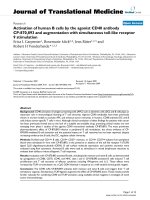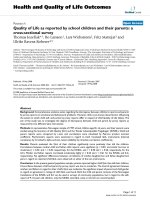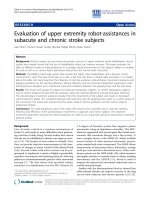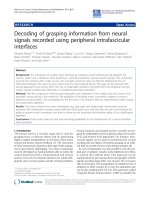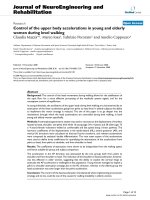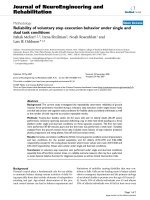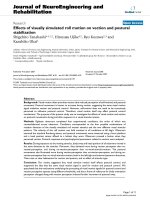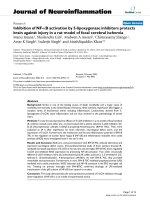báo cáo hóa học: " Inhibition of secreted phospholipase A2 by neuron survival and anti-inflammatory peptide CHEC-9" docx
Bạn đang xem bản rút gọn của tài liệu. Xem và tải ngay bản đầy đủ của tài liệu tại đây (605.86 KB, 9 trang )
BioMed Central
Page 1 of 9
(page number not for citation purposes)
Journal of Neuroinflammation
Open Access
Research
Inhibition of secreted phospholipase A2 by neuron survival and
anti-inflammatory peptide CHEC-9
Timothy J Cunningham*, Jaquie Maciejewski and Lihua Yao
Address: Department of Neurobiology and Anatomy, Drexel University College of Medicine, 2900 Queen Lane, Philadelphia, PA 19129, USA
Email: Timothy J Cunningham* - ; Jaquie Maciejewski - ; Lihua Yao -
* Corresponding author
Abstract
Background: The nonapeptide CHEC-9 (CHEASAAQC), a putative inhibitor of secreted
phospholipase A2 (sPLA2), has been shown previously to inhibit neuron death and aspects of the
inflammatory response following systemic treatment of rats with cerebral cortex lesions. In this
study, the properties of CHEC-9 inhibition of sPLA2 enzymes were investigated, using a venom-
derived sPLA2 group I and the plasma of rats and humans as the sources of enzyme activity. The
results highlight the advantages of inhibitors with uncompetitive properties for inflammatory
disorders including those resulting in degeneration of neurons.
Methods: Samples of enzyme and plasma were reacted with 1-Palmitoyl-2-Pyrenedecanoyl
Phosphatidylcholine, a sPLA2 substrate that forms phospholipid vesicles in aqueous solutions. Some
of the plasma samples were collected from restrained peptide-treated rats in order to confirm the
validity of the in vitro assays for extrapolation to in vivo effects of the peptide. The enzyme reactions
were analyzed in terms of well-studied relationships between the degree of inhibition and the
concentrations of different reactants. We also examined interactions between different
components of the reaction mixture on native polyacrylamide gels.
Results: In all cases, the peptide showed the properties of an uncompetitive (or anti-competitive)
enzyme inhibitor with Ki values less than 100 nanomolar. The electrophoresis experiments
suggested CHEC-9 modifies the binding properties of the enzyme only in the presence of substrate,
consistent with its classification as an uncompetitive inhibitor. Both the in vitro observations and the
analysis of plasma samples from restrained rats injected with peptide suggest the efficacy of the
peptide increases under conditions of high enzyme activity.
Conclusion: Modeling studies by others have shown that uncompetitive inhibitors may be optimal
for enzyme inhibition therapy because, unlike competitive inhibitors, they are not rendered
ineffective by the accumulation of unmodified substrate. Such conditions likely apply to several
instances of neuroinflammation where there are cascading increases in sPLA2s and their substrates,
both systemically and in the CNS. Thus, the present results may explain the efficacy of CHEC-9 in
vivo.
Published: 11 September 2006
Journal of Neuroinflammation 2006, 3:25 doi:10.1186/1742-2094-3-25
Received: 10 June 2006
Accepted: 11 September 2006
This article is available from: />© 2006 Cunningham et al; licensee BioMed Central Ltd.
This is an Open Access article distributed under the terms of the Creative Commons Attribution License ( />),
which permits unrestricted use, distribution, and reproduction in any medium, provided the original work is properly cited.
Journal of Neuroinflammation 2006, 3:25 />Page 2 of 9
(page number not for citation purposes)
Background
Pro-inflammatory enzymes and cytokines are increasingly
attractive as therapeutic targets for a variety of inflamma-
tory diseases and for the inflammatory component of
neurodegenerative disorders. The 14–18 kD secreted
phospholipase A2s (sPLA2s) are of interest in this regard
because of their accessibility in the circulation and
because local and systemic elevation of sPLA2s are associ-
ated with most forms of inflammation [1-5]. The secreted
isoforms are part of a growing family of PLA2 enzymes
whose activity leads to the production of several potent
mediators of inflammation. Increased levels of extracellu-
lar sPLA2s have been detected in the plasma of patients
affected by systemic inflammatory diseases such as acute
pancreatitis, septic shock, extensive burns, and autoim-
mune diseases. The enzymes are also accumulated in
inflammatory fluids such as the synovial fluid of patients
with rheumatoid arthritis, the bronchoalveolar lavage of
patients with bronchial asthma, and the nasal secretions
of patients with allergic rhinitis. More recent experimental
studies suggest sPLA2s are involved in traumatic and
autoimmune precipitated neurodegeneration, and thus
these enzymes are also a potential target for treatment of
nervous system disorders.) [6,7,33].
CHEC-9 is a putative sPLA2 inhibitor that has recently
been identified as an internal fragment of the survival-
promoting, anti-inflammatory polypeptide DSEP/Derm-
cidin/PIF [6,8-12]. Following cerebral cortex lesions, a
subcutaneous injection of CHEC-9 results in anti-inflam-
matory and neuron survival effects that last for at least 4
days, an effect due in part to an interruption of the inflam-
matory cascade that follows damage to the CNS. Given
the efficacy of CHEC-9, the present study was undertaken
to investigate CHEC-9 inhibition of sPLA2 activity in
detail. The results suggest that CHEC-9 has several charac-
teristics of an uncompetitive (or anti-competitive) sPLA2
inhibitor even when tested ex vivo with a chemically com-
plex fluid like plasma. These properties are likely to be
especially advantageous under conditions of inflamma-
tion and associated oxidative stress, and therefore are con-
sistent with the peptide's performance in vivo.
Methods
Sources and preparation of sPLA2
Purified secreted phospholipase A2 group I from the
venom of the Mozambique cobra (Naja mossambica) was
obtained from Sigma. Blood was obtained from the trunk
of 20 female Sprague Dawley rats (200–250 g) after
decapitation, and by venipunture of 14 healthy adult
humans of both sexes. Blood samples from 8 additional
rats were collected following subcutaneous injections of
100 μg CHEC-9 or DMEM vehicle. These rats were placed
in a standard rat restrainer during the collection period
and the samples obtained via a tail nick. All specific pro-
cedures of this study were approved by both the Institu-
tional Animal Care and Use Committee and by
Institutional Review Board of Drexel University College of
Medicine. Blood samples were treated with citrate-phos-
phate-dextrose anticoagulant (1:10, Sigma), and plasma
prepared by centrifugation, before freezing at -80° until
used in the enzyme assays. For the ex vivo studies, individ-
ual plasma samples were pooled from 3–7 rats or 3–5
humans.
Enzyme assays
Enzyme assays were conducted at ambient temperature
(22–25°) using a Victor 3 fluorescent reader (Perkin
Elmer, Nutley NJ). The substrate was 1-Palmitoyl-2-
Pyrenedecanoyl Phosphatidylcholine ("10-pyrene", Cay-
men Chemical, Ann Arbor MI) a substrate for all calcium
dependent PLA2s with the exception of cPLA2 and PAF-
AH. The substrate (supplied in chloroform) was dried
under a nitrogen stream, quickly dissolved in ethanol, and
stored at -20° prior to use. Substrate solutions were pre-
pared in reaction buffer consisting of 50 mM tris (pH =
7.4), 0.1 M NaCl, 2 mM CaCl
2
, 0.25% fatty acid-free albu-
min (Sigma) and the CHEC-9 peptide at the indicated
concentrations. CHEC-9 (CHEASAAQC) was synthesized
by Celtek, (Nashville, TN), purified and cross-linked as
described previously [6], and aliquots stored in tris buffer
or DMEM vehicles at -80°. The 10-pyrene substrate forms
phospholipids vesicles in aqueous solutions [13], and
upon hydrolysis, releases 10-pyrenyldecanoic acid. This
product is fluorescent in the presence of albumin and was
measured at 350 nm excitation, 405 nM emission. Plasma
samples were 20% final concentration in the reaction
mixture, and all enzyme reactions were initiated with the
addition of the substrate solution to the sPLA2 containing
samples. Kinetic parameters including the properties of
CHEC-9 were determined by measuring the initial veloci-
ties (Vo) of enzyme reactions (within 2 minutes of initia-
tion). For experiments in which active sPLA2 enzyme
concentration was measured in plasma samples from pep-
tide-treated rats, we used a single substrate concentration
and measured the steady-state rate of the enzyme reaction
for 30 minutes. This rate is proportional to the concentra-
tion of active enzyme in the plasma if product formation
during this period is linear with respect to time (see Fig.
6). In most experiments, relative fluorescent units (RFU)
were converted to product concentration using a pyrenyl-
decanoic acid standard curve (Molecular Probes, Eugene,
OR). For plasma, the background fluorescence of the
plasma was not subtracted, but this did not effect the
velocity measurements. Individual reactions were carried
out in duplicate or triplicate and kinetic curves were pro-
duced using 5–6 substrate concentrations, with or with-
out peptide, reacted simultaneously. Representative
Lineweaver-Burke plots and nonlinear regression analyses
of reactions using multiple peptide and substrate concen-
Journal of Neuroinflammation 2006, 3:25 />Page 3 of 9
(page number not for citation purposes)
trations are presented in Results. Individual experiments
were repeated 5 or more times with the same result, i.e.,
the direction of change of Km and Vmax was the same fol-
lowing inhibitor treatment, and Ki was less than 100 nM.
Km and Vmax and r
2
were determined with regression
software (Prism) from Graphpad (San Diego, CA).
Identification of inhibitor properties
The characteristics of CHEC-9 inhibition were determined
using both classical characterization of inhibitor types,
i.e., the direction of changes in Km and Vmax, and more
recent reports that derive consistent relationships between
the extent of enzyme inhibition and substrate concentra-
tion [14-17]. The analyses of Geng [14] and Whitely[17]
were particularly useful for the present studies because
they allowed classification of CHEC-9 as well as calcula-
tion of the conventional inhibition constants for the vari-
ous enzyme sources. We have repeated, combined, and
rearranged some of their equations below in order to
show the calculations used in the present experiments.
Ki
NR
is the apparent inhibition constant based on inhibi-
tion degree and is independent of inhibitor classification
[14]. This value varies predictably with substrate concen-
tration for different inhibitor types. It is defined as:
Ki
NR
= [I]·R/(1-R), where [I] = inhibitor concentration,
and
R = velocity
+inhibitor
/velocity
-inhibitor
.
This equation can be rewritten as:
Ki
NR
= [I]·velocity
+inhibitor
/(velocity
-inhibitor
- velocity
+inhibi-
tor
) for expressing Ki
NR
in terms of measured velocities. For
the experiments in which the Michaelis constant Km was
reliably estimated by nonlinear regression, Ki for an
uncompetitive inhibitor was calculated from the follow-
ing:
R = 1/(1 + ([I]/Ki·(1+(Km/[S])), where [S] = concentra-
tion of substrate.
This rearranges to: Ki = (R/(1-R))·[I]/(1+(Km/[S])), or, in
terms of Ki
NR
:
Ki = Ki
NR
/(1+(Km/[S])).
Polyacrylamide gel electrophoresis
Polyacrylamide gradient gels (5–15%) were run with and
without SDS or reducing agents using sPLA2 group I alone
or after mixing the enzyme with different combinations of
the components of the reaction mixture (or their sol-
vents). Samples prepared for the native gels were 50 μl
containing 26 μM sPLA2, 40 μM CHEC-9, 560 μM 1-
Palmitoyl-2-Pyrenedecanoyl Phosphatidylcholine (sub-
strate), and 2 mM CaCl
2
in 20 mM tris buffer (pH = 7.4),
incubated together at room temperature for 30 min. After
incubation, the samples were evaporated to 20 μl. The
samples were then mixed with sample buffer containing
only glycerol and bromophenol blue in 0.1 M tris (pH =
6.8) and loaded onto the gels. Following electrophoresis,
the gels were washed, fixed, and stained with silver rea-
gent according to conventional methods. The native gel
experiment, using different reactant combinations run
side by side (Fig. 3), was repeated four times with the
same result.
Results
sPLA2 group I
The properties of CHEC-9 reacted with sPLA2 group I
were examined using substrate concentrations that were
one-half or less than the Michaelis constant (Km) meas-
ured during the course of the experiments, a relationship
that is necessary for differentiating between different types
of inhibitors [14]. Under these conditions, we found that
the velocity of the enzyme reaction was reduced by
nanomolar concentrations of CHEC-9 in the reaction
mixture and the extent of inhibition depended on the
concentration of both
enzyme and substrate. For example,
at the lowest substrate concentrations used in these exper-
iments, CHEC-9 was minimally effective, ineffective, or
even potentiated Vo. As a result, convergant lines
appeared in the Lineweaver-Burke plots as 1/[S] increased
(i.e., as substrate concentration decreased, Fig. 1). The
intercepts of these plots suggested that CHEC-9 reduced
both the Vmax and Km of the enzyme reaction, a result
that was confirmed by nonlinear regression analyses after
fitting all the data to the Michaelis-Menton equation
(Table 1). This analysis suggested therefore that CHEC-9's
properties were most consistent with an uncompetitive
(or anti-competitive) inhibitor of sPLA2 group I. Further-
more, the apparent inhibition constant (Ki
NR
), calculated
from the reaction velocities, varied inversely with the sub-
strate concentration (Fig. 1, inset), another characteristic
of an uncompetitive inhibitor[14].
Uncompetitive inhibitors are presumed to bind the
enzyme-substrate complex so their efficacy is dependent
on the levels of both enzyme and substrate in the reaction
medium. In the next experiments, we determined effects
of varying the enzyme concentration on CHEC-9 inhibi-
tion. We wanted to test the proposition that increasing the
level of enzyme in the reaction, with a fixed substrate con-
centration, would make low concentrations of the inhibi-
tor more effective due to increased availability of the
enzyme-substrate complex. We measured velocities in
reaction mixtures containing sPLA2 at 2, 6 and 10 nM
mixed with CHEC-9 at 0, 0.1,1, and 10 nM (Fig. 2). For all
concentrations of CHEC-9, maximal reductions of Vo
Journal of Neuroinflammation 2006, 3:25 />Page 4 of 9
(page number not for citation purposes)
occurred at 10 nM sPLA2, the highest concentration of
enzyme tested. CHEC-9 concentrations lower than 10 nM,
although minimally effective or ineffective at 2 nM or 6
nM sPLA2, produced consistent reductions in reaction
velocity when used with 10 nM enzyme (Fig. 2). Thus
increasing the enzyme concentration increased the effi-
cacy of CHEC-9.
Polyacrylamide gel electrophoresis
In the electrophoresis experiments the concentrations of
the participants in the reaction were scaled up so the
migration of the enzyme on native gels could be observed
following incubation with various reactants. We first con-
firmed that the sPLA2 used in these experiments was a sin-
gle species after electrophoresis using conventional
buffers with or without SDS and reducing reagents (not
shown). The native gels had high argentophilic back-
ground but a single discrete sPLA2 band was still observed
when the enzyme was pre-incubated in only the modified
tris-calcium reaction buffer (without substrate or peptide,
lane 2, Fig. 3). The same band appeared when either sub-
strate or peptide alone was added to this mixture (lanes 3
and 4 arrowhead), although in the case of the former, a
large, irregular, and intensely argentophilic band also
appeared nearer the top of the gels, presumably represent-
ing a product or intermediate in the enzyme-substrate
reaction. This same large band was also apparent when
CHEC-9, enzyme and substrate were all present in the
sample. However, the sPLA2 band was absent or at least
dramatically reduced with CHEC-9 present (lane 1). Since
the sPLA2 disappears or is diminished only in the pres-
ence of substrate and CHEC-9, it is suggested that peptide,
substrate, and enzyme formed a complex that precluded
the migration of the enzyme to its typical position in
native gels. This result was consistent with the properties
of an uncompetitive inhibitor.
Human plasma
Human plasma required higher concentrations of sub-
strate while reaching lower reaction velocities than sPLA2
group I. The Km values calculated for these plasma reac-
tions were therefore higher. However, the pattern of inhi-
Lineweaver-Burke double reciprocal plots showing CHEC-9 inhibition of sPLA2 group IFigure 1
Lineweaver-Burke double reciprocal plots showing CHEC-9 inhibition of sPLA2 group I. The 10-pyrene substrate,
at concentrations between 2 and 7 μM, was reacted with 5 nM sPLA2 and CHEC-9 at 0, 0.1, 1.0, and 10 nM. Plots of 1/Vo
against 1/[substrate, S] gave convergent lines at higher values of 1/[S] (lower substrate concentrations) suggesting that the inhi-
bition was dependent on substrate concentration. Plots of the apparent inhibition constant Ki
NR
vs. [S] (upper left) showed an
overall decline in this value with increasing substrate concentration for each peptide concentration which is characteristic of an
uncompetitive inhibitor. This is confirmed by computation of the kinetic parameters shown in Table 1 after fitting the data to
the Michaelis-Menton hyperbola. [r
2
, p values for linearity of reciprocal plots: 0 nM – 0.945, 0.0012; 0.1 nM – 0.947, 0.0011; 1.0
nM – 0.868, 0.0069; 10 nM – 0.810, 0.0145].
Journal of Neuroinflammation 2006, 3:25 />Page 5 of 9
(page number not for citation purposes)
bition of enzyme activity was nearly identical to that
obtained with purified sPLA2 (Fig. 4). In the first place,
the peptide produced exaggerated enzyme activity in
human plasma at the lowest substrate concentrations
used. This is a classical feature of uncompetitive inhibi-
tion because at low substrate concentrations the mass
action effects of the inhibitor facilitated formation of the
ES complex, which elevated the initial reaction velocity
(Vo) compared to the reaction without peptide. Most
importantly, Km and Vmax of plasma samples were both
reduced by CHEC-9 under these conditions (Table 1),
which is the hallmark of the uncompetitive inhibitor.
Rat plasma
The kinetic behaviour of rat plasma reacted with the 10-
pyrene substrate was complex. The expected progression
of activity with increasing substrate concentration was
often interrupted abruptly at high substrate concentra-
tions (> 25 μM) by profound inhibition of activity, even
without peptide treatment. CHEC-9 would sometimes
reverse this inhibitory effect, suggesting a complex com-
petitive relationship between substrate, rat plasma
sPLA2(s), and CHEC-9 under these conditions. Nonethe-
less, during individual reactions at lower substrate con-
centrations, when product formation was relatively stable,
inhibition by CHEC-9 was readily observed. The charac-
teristics of these individual enzyme reactions were consist-
ent with the properties of CHEC-9 described above. For
example, at very low substrate concentrations, CHEC-9
inhibition of rat plasma sPLA2 was delayed (Fig. 5, left
panel). The delay may indicate the requirement for forma-
Silver-stained SDS gel showing the migration of sPLA2 group I on native gelsFigure 3
Silver-stained SDS gel showing the migration of
sPLA2 group I on native gels. The enzyme was incubated
with various components of the reaction mixture in calcium
containing buffer as described in Methods. The sPLA2 band
(arrowhead) disappeared or was markedly attenuated when
the enzyme was pre-incubated with both peptide and sub-
strate (lane 1), but not after incubation with buffer, substrate,
or peptide alone (lanes 2, 3, 4). The gels suggested that the
peptide could modify the structure and/or binding properties
of the enzyme only in the presence of substrate.
Table 1: Kinetic Parameters at Different Inhibitor
Concentrations
Group I sPLA2
[CHEC-9] nM 0.0 0.1 1.0 10.0
Vmax nM/min/ng 21.67 11.54 5.56 4.04
Km μM 18.80 10.77 3.40 2.26
r
2
0.896 0.942 0.851 0.752
Ki = 4.02 ± 1.56 nM
Human Plasma sPLA2
[CHEC-9] nM 0.0 10.0 50.0
Vmax μM/min/ml 2.07 1.42 0.973
Km 66.52 40.79 24.06
r
2
.981 .957 .970
Ki = 62.01 ± 13.2 nM
r
2
= fit to Michaelis-Menton Equation
Increasing efficacy of CHEC-9 with increasing enzyme con-centrationsFigure 2
Increasing efficacy of CHEC-9 with increasing
enzyme concentrations. The graph shows Vo for 3 differ-
ent concentrations of enzyme reacted with 6 μM 10-Pyrene.
Data points are mean ± s.e.m. of reactions with and without
peptide (* indicates a significant difference, p < .05, t-test). All
three concentrations of peptide were most effective at the
highest concentration of sPLA2, and showed declining effi-
cacy at the lower enzyme concentrations (see text).
Journal of Neuroinflammation 2006, 3:25 />Page 6 of 9
(page number not for citation purposes)
tion of a sufficient level of the ES complex, as also sug-
gested in the experiments above. With increased substrate
concentrations (right panel) this delay of the inhibition is
not detected, as quantities of the ES complex necessary for
inhibition by the peptide are present instantaneously
(within the present limits of detection). This situation is
in fact equivalent to the inhibition of Vo in the previous
experiments, which was most apparent at higher substrate
concentrations.
In vivo experiments
In order to verify that the results of these in vitro and ex vivo
assay procedures were appropriate for comparison to the
in vivo effects of CHEC-9, we injected rats with peptide
(100 μg) or vehicle, collected plasma samples, and then
used the 10-pyrene substrate to measure sPLA2 activity.
For these samples, the rate of product formation was
determined over a 30-minute period in the presence of 15
μM substrate. We confirmed that the reaction was linear
during the period of measurement so the measured rate of
the reaction was proportional to the concentration of
active enzyme in the plasma (Fig. 6). Samples collected at
15–30 min intervals following treatment showed a tran-
sient elevation in sPLA2 levels at 30 and 60 minutes, pre-
sumably due to the stress of restraint, blood sampling,
and/or the injection procedures (Fig. 7). This increase was
inhibited in the peptide-injected rats. In these rats, CHEC-
9 appeared to 'buffer' the sPLA2 activity, holding the level
of active enzyme, on average, near pre-injection values.
These results are also consistent with the activity-depend-
ent inhibition by the peptide, as suggested by the in vitro
and ex vivo experiments outlined above.
Enzyme reactions using rat plasma with and without 25 nM CHEC-9 added to the reaction mixtureFigure 5
Enzyme reactions using rat plasma with and without 25 nM CHEC-9 added to the reaction mixture. These reac-
tions were characterized by delayed inhibition at the lower substrate concentrations, which is consistent with uncompetitive
inhibition (see text). Each point represents the mean ± s.e.m. of three reactions.
Lineweaver-Burke double reciprocal plots showing CHEC-9 inhibition of sPLA2 activity in human plasmaFigure 4
Lineweaver-Burke double reciprocal plots showing
CHEC-9 inhibition of sPLA2 activity in human
plasma. Plasma concentration was 20% of the reaction mix-
ture, which also consisted of 10-pyrene at concentrations
between 5–30 μM and CHEC-9 at 0, 10 and 50 nM. CHEC-9
was less effective or even exaggerated the reaction at the
lower substrate concentrations causing the lines of the plot
to converge with increasing values of 1/[S]. The kinetic
parameters for reactions with human plasma are shown in
Table 1 and are consistent with the properties of an uncom-
petitive inhibitor. [r
2
, p values for linearity of reciprocal plots:
0 nM – 0.987, 0.006; 10 nM – 0.967, 0.0026; 50 nM – 0.980,
0.0012].
Journal of Neuroinflammation 2006, 3:25 />Page 7 of 9
(page number not for citation purposes)
Discussion
Competitive versus uncompetitive inhibitors
Studies of enzyme inhibitors in open systems have sug-
gested that competitive inhibitors, still a major focus of
therapeutic drug design, have inherent limitations that
may compromise their efficacy [18]. These limitations
involve the accumulation of unmodified substrate, a nat-
ural result of blocking of the enzyme binding to substrate
by the inhibitor. The accumulated substrate will eventu-
ally compete successfully for the enzyme overcoming the
inhibition. These limitations are expected to be especially
apparent in situations of both acute and persistent inflam-
mation, the conditions that are amenable to sPLA2 inhi-
bition therapy. Even a more or less localized
inflammatory lesion is accompanied by both a localized
and systemic sPLA2 response as has been demonstrated
for a variety of disorders, including following nervous sys-
tem lesions (see Introduction). Inflammation and associ-
ated oxidative stress will also increase levels of sPLA2
substrates including, (but not exclusively), acidic phos-
pholipids expressed at the cell surface [19], phosphatidic
acid released by activated immune cells[20,21], and oxi-
dized low density lipoproteins, components of the phos-
pholipid targets in circulating lipoproteins [22,23].
Successful enzyme inhibition therapy, introduced system-
ically, must therefore overcome widespread elevations in
enzyme and available substrates. The uncompetitive
sPLA2 inhibitor may have an advantage under such con-
ditions, since this increased activity may actually favor the
enzyme inhibition. Therefore, competitive sPLA2 inhibi-
tors, even those displaying potent inhibition in vitro, may
have short-lived effects in vivo depending on the level and
persistence of the inflammatory response. It is possible
that this limitation contributed to the lack of in vivo effi-
cacy of a number of potent small molecule competitive
sPLA2 inhibitors developed commercially and aban-
doned [4], as well as to the poor performance of compet-
itive sPLA2 inhibitors in recent clinical trials [4,24,25]. It
should be noted however that these inhibitors were not
tested in models of neurodegenerative disease.
Neurodegeneration and PLA2 isoforms
The survival-promoting and anti-inflammatory effects of
CHEC-9 are most readily explained by the inhibition of
PLA2 activity, either sPLA2s directly, or cytosolic PLA2
which may be regulated by sPLA2s during oxidative stress
Reduced levels of active sPLA2 enzyme in rat plasma samples after systemic delivery of CHEC-9Figure 7
Reduced levels of active sPLA2 enzyme in rat plasma
samples after systemic delivery of CHEC-9. A transient
rise in mean levels of active enzyme was found in the first 60
min after vehicle injections in restrained rats. CHEC-9 inhib-
its this increase at 30 and 60 min. Each data point represents
the mean ± s.e.m. of 4 rats (2–3 measurements/time pt./rat)
in each of the two treatment groups. The values are
expressed as a percent of the pre-injection samples for indi-
vidual rats. (*) represents significant differences at 30 and 60
minutes (p < 0.05 by Mann Whitney test).
Linear formation of reaction product over time in plasma samples from rats injected with CHEC-9 or vehicleFigure 6
Linear formation of reaction product over time in
plasma samples from rats injected with CHEC-9 or
vehicle. The rats were restrained for blood sampling and
then injected with 100 μg peptide or equivalent volume of
vehicle under the skin of the back. The reactions of plasma
showed a roughly linear increase in product for the period of
measurement using 15 μM of the 10-pyrene substrate.
Therefore the concentration of active enzyme in the plasma
is proportional to the rate of the reaction. Examples shown
are samples from peptide and vehicle-treated rats taken 30
minutes after treatment, and a plasma sample from a vehicle
injected animal prior to treatment. RFU = relative fluores-
cent units.
Journal of Neuroinflammation 2006, 3:25 />Page 8 of 9
(page number not for citation purposes)
[19,26,27]. The activity of the PLA2 enzymes has been
associated with cell degeneration in many systems includ-
ing the nervous system [28,29]. Furthermore, microglia
and macrophages may depend on PLA2 activity for cell
killing [30,31]. At present, the PLA2 isoforms targeted by
CHEC-9, where in vivo they are targeted, and their rele-
vance to particular neurodegenerative disorders is
unknown. We have emphasized ex vivo experiments with
plasma and sPLA2 activity in plasma after in vivo exposure
to CHEC-9 because these fluids, while complex in terms
of the number of active PLA2 isoforms present [2,22],
likely contribute to the systemic component of neuroin-
flammatory disorders. In fact, the efficacy of CHEC-9 in
plasma, as well as with a venom-derived sPLA2, indicates
broad specificity of the peptide, which may also contrib-
ute to its effectiveness in vivo. The nonenzymatic functions
of PLA2 enzymes may also contribute to the pathophysi-
ology of neurodegenerative diseases, and CHEC-9 could
also influence these activities at the same time or inde-
pendently of enzyme inhibition [2,32].
Conclusion
The contribution of sPLA2 enzyme activity to inflamma-
tory and degenerative disorders of the nervous system is
increasingly appreciated. Given the nature of inflamma-
tory stimuli and of the inflammatory cascade, inhibitors
of enzyme activity with uncompetitive properties may be
optimal for therapeutic intervention, since their efficacy is
increased under conditions of escalating enzyme activity.
Competing interests
TJC, LY, and Drexel University have applied for patent
protection of CHEC-9, the peptide inhibitor used in these
experiments.
Authors' contributions
JM conducted the enzyme assays and LY was responsible
for the in vivo studies. TJC organized the data following
computer analysis and wrote the manuscript. All authors
contributed to design of the experiments and interpreta-
tion of data, and trouble-shooting the specific procedures
involved. All authors approved of the final version of the
manuscript.
Acknowledgements
This work was supported by a grant from the Amyotrophic Lateral Sclero-
sis Association.
References
1. Corke C, Glenister K, Watson T: Circulating secretory phos-
pholipase a(2) in critical illness – the importance of the intes-
tine. Crit Care Resusc 2001, 3:244-249.
2. Triggiani M, Granata F, Giannattasio G, Marone G: Secretory phos-
pholipases A2 in inflammatory and allergic diseases: not just
enzymes. J Allergy Clin Immunol 2005, 116:1000-1006.
3. Touqui L, Alaoui-El-Azher M: Mammalian secreted phospholi-
pases A2 and their pathophysiological significance in inflam-
matory diseases. Curr Mol Med 2001, 1:739-754.
4. Springer DM: An update on inhibitors of human 14 kDa Type
II s-PLA2 in development. Curr Pharm Des 2001, 7:181-198.
5. Meyer MC, Rastogi P, Beckett CS, McHowat J: Phospholipase A2
inhibitors as potential anti-inflammatory agents. Curr Pharm
Des 2005, 11:1301-1312.
6. Cunningham TJ, Souayah N, Jameson B, Mitchell J, Yao L: Systemic
treatment of cerebral cortex lesions in rats with a new
secreted phospholipase A2 inhibitor. J Neurotrauma 2004,
21:1683-1691.
7. Pinto F, Brenner T, Dan P, Krimsky M, Yedgar S: Extracellular
phospholipase A2 inhibitors suppress central nervous sys-
tem inflammation. Glia 2003, 44:275-282.
8. Cunningham TJ, Hodge L, Speicher D, Reim D, Tyler-Polsz C, Levitt
P, Eagleson K, Kennedy S, Wang Y: Identification of a survival-
promoting peptide in medium conditioned by oxidatively
stressed cell lines of nervous system origin. J Neurosci 1998,
18:7047-7060.
9. Cunningham TJ, Jing H, Akerblom I, Morgan R, Fisher TS, Neveu M:
Identification of the human cDNA for new survival/evasion
peptide (DSEP): studies in vitro and in vivo of overexpres-
sion by neural cells. Exp Neurol 2002, 177:32-39.
10. Landgraf P, Sieg F, Wahle P, Meyer G, Kreutz MR, Pape HC: A
maternal blood-borne factor promotes survival of the devel-
oping thalamus. Faseb J 2005, 19:225-227.
11. Schittek B, Hipfel R, Sauer B, Bauer J, Kalbacher H, Stevanovic S,
Schirle M, Schroeder K, Blin N, Meier F, et al.: Dermcidin: a novel
human antibiotic peptide secreted by sweat glands. Nat
Immunol 2001, 2:1133-1137.
12. Lowrie AG, Wigmore SJ, Wright DJ, Waddell ID, Ross JA: Dermci-
din expression in hepatic cells improves survival without N-
glycosylation, but requires asparagine residues. Br J Cancer
2006, 94:1663-1671.
13. Radvanyi F, Jordan L, Russo-Marie F, Bon C: A sensitive and con-
tinuous fluorometric assay for phospholipase A2 using
pyrene-labeled phospholipids in the presence of serum albu-
min. Anal Biochem 1989, 177:103-109.
14. Geng W: A method for identification of inhibition mechanism
and estimation of Ki in in vitro enzyme inhibition study. Drug
Metab Dispos 2003, 31:1456-1457.
15. Cortes A, Cascante M, Cardenas ML, Cornish-Bowden A: Relation-
ships between inhibition constants, inhibitor concentrations
for 50% inhibition and types of inhibition: new ways of analys-
ing data. Biochem J 2001, 357:263-268.
16. Ito K, Iwatsubo T, Kanamitsu S, Ueda K, Suzuki H, Sugiyama Y: Pre-
diction of pharmacokinetic alterations caused by drug-drug
interactions: metabolic interaction in the liver. Pharmacol Rev
1998, 50:387-412.
17. Whiteley CG: Enzyme kinetics: partial and complete uncom-
petitive inhibition. Biochem Educ 2000, 28:144-147.
18. Westley AM, Westley J: Enzyme inhibition in open systems.
Superiority of uncompetitive agents. J Biol Chem 1996,
271:5347-5352.
19. Kuwata H, Sawada H, Murakami M, Kudo I: Role of type IIA secre-
tory phospholipase A2 in arachidonic acid metabolism. Adv
Exp Med Biol 1999, 469:183-188.
20. Kusner DJ, Hall CF, Jackson S: Fc gamma receptor-mediated
activation of phospholipase D regulates macrophage phago-
cytosis of IgG-opsonized particles. J Immunol 1999,
162:2266-2274.
21. Snitko Y, Yoon ET, Cho W: High specificity of human secretory
class II phospholipase A2 for phosphatidic acid. Biochem J 1997,
321(Pt 3):737-741.
22. Pruzanski W, Lambeau L, Lazdunsky M, Cho W, Kopilov J, Kuksis A:
Differential hydrolysis of molecular species of lipoprotein
phosphatidylcholine by groups IIA, V and X secretory phos-
pholipases A2. Biochim Biophys Acta 2005, 1736:38-50.
23. Memon RA, Staprans I, Noor M, Holleran WM, Uchida Y, Moser AH,
Feingold KR, Grunfeld C: Infection and inflammation induce
LDL oxidation in vivo. Arterioscler Thromb Vasc Biol 2000,
20:1536-1542.
24. Zeiher BG, Steingrub J, Laterre PF, Dmitrienko A, Fukiishi Y, Abra-
ham E: LY315920NA/S-5920 a selective inhibitor of group IIA
secretory phospholipase A2, fails to improve clinical out-
come for patients with severe sepsis. Crit Care Med 2005,
33:1741-1748.
Publish with Bio Med Central and every
scientist can read your work free of charge
"BioMed Central will be the most significant development for
disseminating the results of biomedical researc h in our lifetime."
Sir Paul Nurse, Cancer Research UK
Your research papers will be:
available free of charge to the entire biomedical community
peer reviewed and published immediately upon acceptance
cited in PubMed and archived on PubMed Central
yours — you keep the copyright
Submit your manuscript here:
/>BioMedcentral
Journal of Neuroinflammation 2006, 3:25 />Page 9 of 9
(page number not for citation purposes)
25. Bradley JD, Dmitrienko AA, Kivitz AJ, Gluck OS, Weaver AL,
Wiesenhutter C, Myers SL, Sides GD: A randomized, double-
blinded, placebo-controlled clinical trial of LY333013 a selec-
tive inhibitor of group II secretory phospholipase A2, in the
treatment of rheumatoid arthritis. J Rheumatol 2005,
32:417-423.
26. Fonteh AN, Atsumi G, LaPorte T, Chilton FH: Secretory phosphol-
ipase A2 receptor-mediated activation of cytosolic phos-
pholipase A2 in murine bone marrow-derived mast cells. J
Immunol 2000, 165:2773-2782.
27. Han WK, Sapirstein A, Hung CC, Alessandrini A, Bonventre JV:
Cross-talk between cytosolic phospholipase A2 alpha
(cPLA2 alpha) and secretory phospholipase A2 (sPLA2) in
hydrogen peroxide-induced arachidonic acid release in
murine mesangial cells: sPLA2 regulates cPLA2 alpha activ-
ity that is responsible for arachidonic acid release. J Biol Chem
2003, 278:24153-24163.
28. Cummings BS, McHowat J, Schnellmann RG: Phospholipase A(2)s
in cell injury and death. J Pharmacol Exp Ther 2000, 294:793-799.
29. Bazan NG, Colangelo V, Lukiw WJ: Prostaglandins and other
lipid mediators in Alzheimer's disease. Prostaglandins Other Lipid
Mediat 2002, 68–69:197-210.
30. Klegeris A, McGeer PL: Interaction of various intracellular sig-
naling mechanisms involved in mononuclear phagocyte tox-
icity toward neuronal cells. J Leukoc Biol 2000, 67:127-133.
31. Klegeris A, McGeer PL: Toxicity of human monocytic THP-1
cells and microglia toward SH-SY5Y neuroblastoma cells is
reduced by inhibitors of 5-lipoxygenase and its activating
protein FLAP. J Leukoc Biol 2003, 73:369-378.
32. Fuentes L, Hernandez M, Nieto ML, Sanchez Crespo M: Biological
effects of group IIA secreted phosholipase A(2). FEBS Lett
2002, 531:7-11.
33. Cunningham TJ, Yao L, Oetinger M, Cort L, Blankenhorn EP, Green-
stein JI: Secreted phospholipase A2 activity in experimental
autoimmune encephalomyelitis and multiple sclerosis. J Neu-
roinflammation 2006, 3:26.

